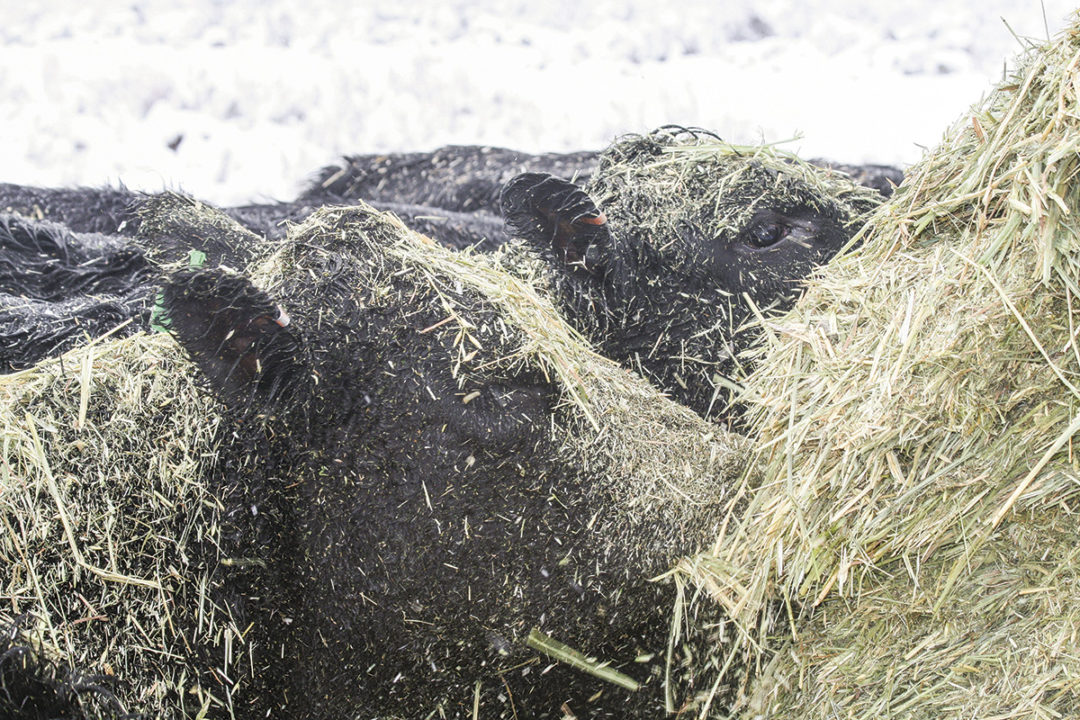By now it’s no secret: Hay yields have been a little short this year. Coupled with the fact that we carried over very little inventory last winter, it is time to do some serious planning to survive winter feeding this year. Fortunately, planning can pay big time in managing your forage inventory and allow you to be proactive with technology investment to improve utilization of your stored forage.
Planning
As a producer, countless tools and technologies are available to you to help stretch forage inventory, and they all work better when applied proactively. For example, it is much easier to reduce hay use by 10% for the entire winter feeding period versus saving 40% for the last 60 days. Planning can be difficult when it comes to winter feeding because we have no idea what fall forage will produce, when spring will come or how hard winter will be. I haven’t found anyone who can truly predict short- and long-term weather, so I encourage every producer to operate in the known and use historical averages when it comes to planning.
Usually, we know how many animals need winter feed and what nutrients they require, on average, when winter begins and again when spring starts. Once the baling and nutrient analysis are complete, you will know what nutrients are available. When you calculate your winter nutrient requirements and discover your current hay inventory isn’t adequate, there are multiple ways to navigate toward a sufficient nutrient inventory. In broad terms, your options are to:
- Reduce animals to carry
- Improve utilization of current forage inventory
- Produce or purchase more feed
- Reduce cattle inventory
In a year when hay is short, reducing cattle inventory can be a good option. A good place to start would be open, old or unproductive cows, which can also present some opportunity to improve performance of the herd. The other good option to consider would be weaning and/or selling calves early to reduce forage needs from the calves and nutrient requirements of the cow. Keep in mind, we can always reduce inventory, but it may not be the most profitable move in this market environment, since calf prices are still good from a historical perspective.
Forage use efficiency
Perhaps the easiest place to look is using your current forage inventory more efficiently. There could be an opportunity to reduce forage loss by as much as 30% to 50% through storage and feeding enhancements.
Research has shown that storing hay outside with soil contact and no cover can result in forage losses of 15% to 18%. By simply reducing soil contact and covering hay with a tarp, we can reduce losses during storage by 5% to 8%. An average-quality tarp costs about $3 per bale, and the use of tires to prevent soil contact is often free. Moreover, research has demonstrated that animals waste twice as much during feeding when hay is stored outside compared to when hay is stored inside or under cover.
Total forage losses due to storage programs can range from 15% to 45%. If hay is worth $100 per ton and costs $5 per ton to protect from the elements, reduction in forage waste would be valued at $20 per ton. Changing your storage program would be a great place to start reducing forage needs in your operation.
Feeding practices would be the next area to evaluate during years of short forage. Common methods for feeding forage would be unrolling on the ground, providing free choice in bale rings or processing and feeding daily. Hay waste during feeding can vary tremendously depending on the method used. Research suggests forage waste during feeding is greatest when unrolling hay on the ground, while waste when feeding in bale feeders can vary dramatically depending on bale feeder design. A small investment in hay-saving feeders or feeding equipment can yield big savings in a year when forage is short.
Another practical option to reduce winter forage needs is the use of feed additives to improve feed efficiency. An ionophore can be a great tool to reduce forage use. When maintaining a cow, we can reduce nutrient needs from 5% to 10% by simply incorporating an ionophore into our feeding program. If ionophores are not a good option for your program, then consider a probiotic or essential oil product that supports efficiency; just make sure it is well researched. Combining an ionophore with one of these products can provide even better forage savings.
Produce or purchase feed
Once you determine hay inventory is not adequate for your winter needs, consider purchasing or producing more feed with the resources available to you. Fortunately, as a producer, options are available to produce more feed. You could use warm-season grasses for hay crops, such as sorghum sudangrass, if we can catch late-summer rains.
Fall fertilizing and stockpiling cool-season grasses can be another good option to extend the grazing season and reduce stored forage needs. As a rule of thumb, every pound of nitrogen applied per acre in the fall will result in 25 pounds of forage produced. With current fertilizer values, it would cost roughly $35 per acre to apply 50 pounds of nitrogen. In theory, that 50 pounds of nitrogen should provide another 1,250 pounds of forage per acre. If the cow utilizes half of our stockpiled forage, the resulting feed cost would only be $112 per ton.
Economics
Economics drive the decisions we make, and many operations crunch numbers differently. When it comes to your winter feeding program, being proactive can pay big versus needing to liquidate cows. There are a lot of unknowns, but try to plan for your average needs and save some resources for the unexpected. I encourage every producer to evaluate their current program and look for opportunities to utilize forage more efficiently by capitalizing on tools and technologies available to make your operation more profitable.










